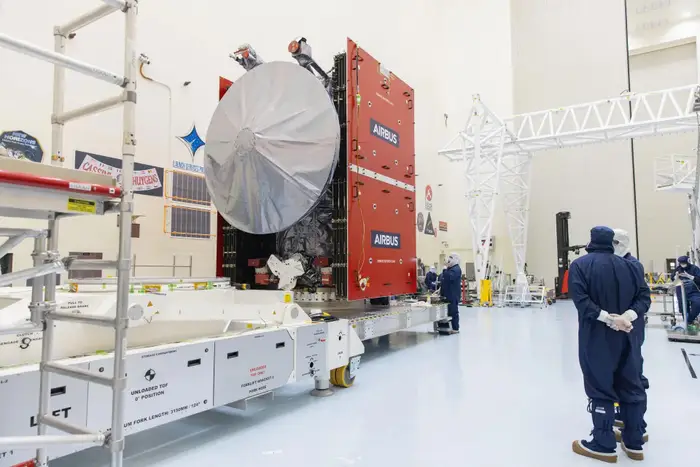NASA launches a probe to find out if there really could be alien life on Jupiter’s moon Europa

A SpaceX Falcon Heavy rocket lifts off carrying NASA’s Europa Clipper mission.
NASA is serious about searching for alien life, even within our own solar system.
On Monday, the agency launched a spacecraft aboard a SpaceX Falcon Heavy rocket toward Europa, a moon of Jupiter.
Scientists believe Europa contains a vast saltwater ocean deep beneath its icy crust, with twice as much water as Earth. It’s perhaps the most promising place in our solar system for active extraterrestrial life.

Europa, as imaged by NASA’s Galileo spacecraft in the late 1990s.
The NASA mission, called Europa Clipper, aims to figure out whether the Jupiter moon and its ocean could support life. It’s the largest interplanetary spacecraft NASA has ever built. The probe is about 16 feet tall and, when its vast wings of solar arrays are deployed, 100 feet wide. It weighs 3 1/2 tons.
Clipper is undertaking the first targeted exploration of an ocean world beyond our planet.
Even if there is no life on Europa, this mission is crucial in the search for alien life, since ocean worlds across the galaxy are prime candidates for life.
Missions like Europa Clipper are “modern cathedrals” and “generational quests,” said Laurie Leshin, the director of NASA’s Jet Propulsion Laboratory, which built the spacecraft.

The Europa Clipper spacecraft at NASA’s Kennedy Space Center in Florida.
“We scientists have been dreaming about a mission like Europa Clipper for more than 20 years. We’ve been working to build it for 10 years,” she added in a briefing about the mission in September. “It’s going to be another 10 years, because Jupiter’s so far away, until we have all the science in the bag.”
The spacecraft must travel 1.8 billion miles to get to Jupiter, getting a boost from Mars’ gravity along the way. It’s scheduled to arrive in April 2030.
A 7-body problem and unfathomable radiation
Life exists without sunlight at the bottom of the ocean here on Earth. All it needs is an energy source, like hydrothermal vents that release heat from deep within the planet, and organic molecules containing essential elements like carbon, nitrogen, oxygen, and hydrogen.
Europa Clipper is carrying nine scientific instruments to look for the fingerprints of those molecules, measure the salinity and depth of the underground ocean, and take photos of Europa down to 1 meter of resolution, among other tasks.

An artist’s concept of NASA’s Europa Clipper spacecraft.
“Clipper is not actually going to look for life itself, but it’s going to characterize the habitability of Europa,” Gina DiBraccio, the acting director of NASA’s Planetary Science Division, said in the briefing.
The mission is designed to orbit Jupiter and fly past Europa 49 times, each time soaring over a different area to eventually cover almost the entire moon, pole to pole. The spacecraft will get as close as 16 miles above Europa’s surface.
The mission plan is a marvel of engineering. Jordan Evans, the mission’s project manager, said in the briefing that rather than a three-body problem, falling into orbit around Jupiter is a “seven-body problem” because of the planet’s large moons.
During each flyby, Clipper will bathe in radiation from Jupiter that’s equivalent to “a few million chest X-rays,” Evans added.
It might even find out if Europa’s ice really glows in the dark from that radiation, as NASA research has previously indicated.





